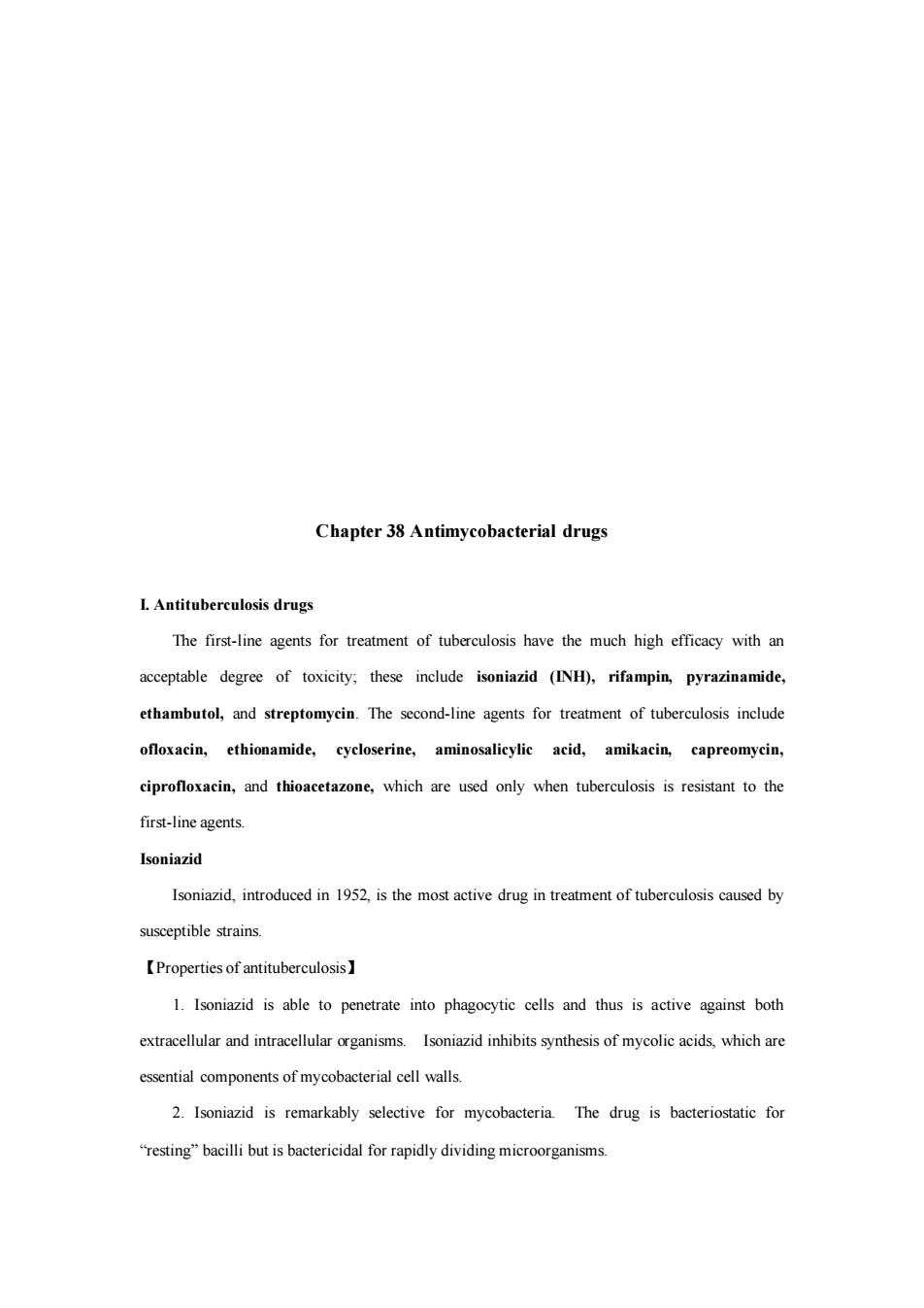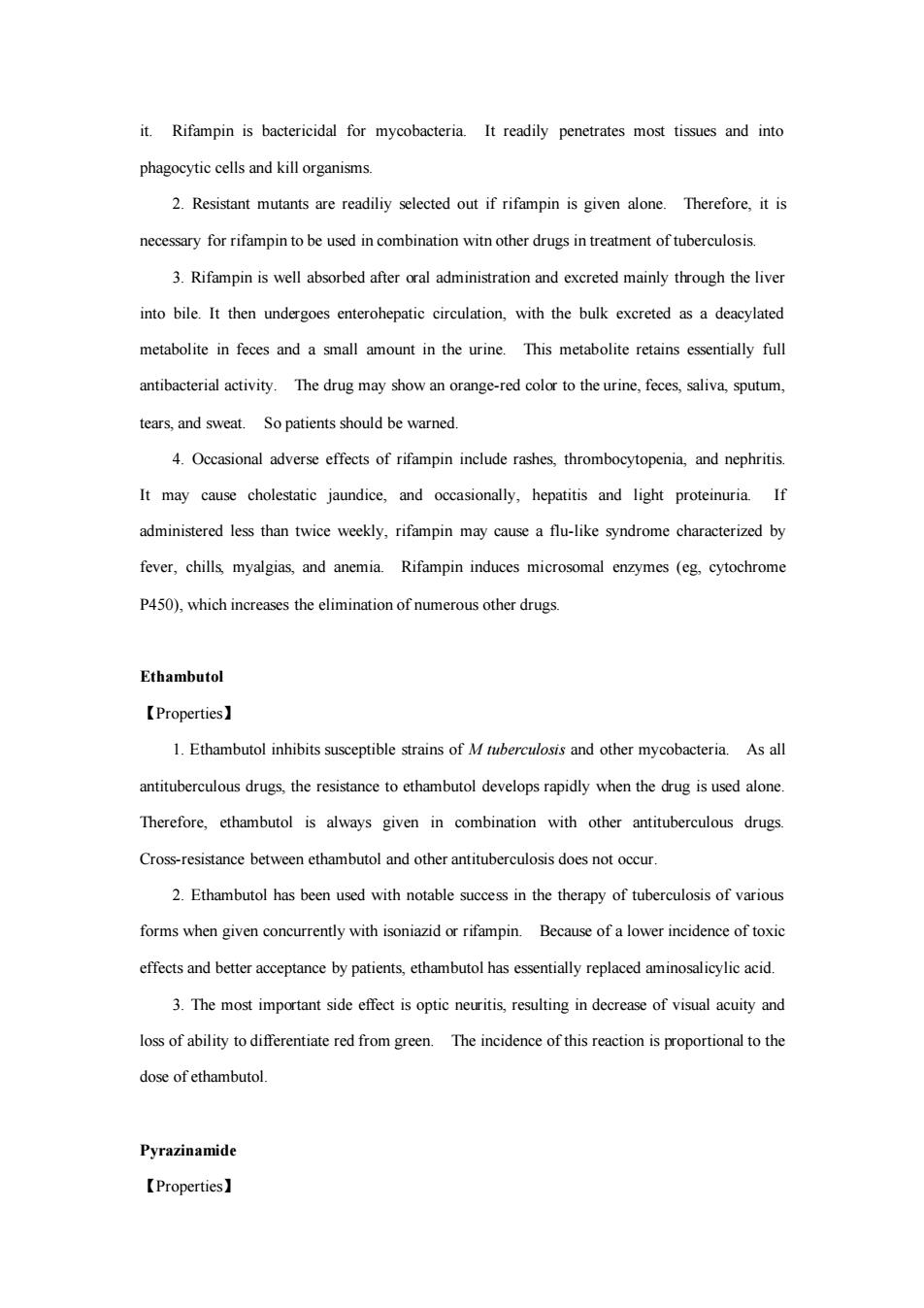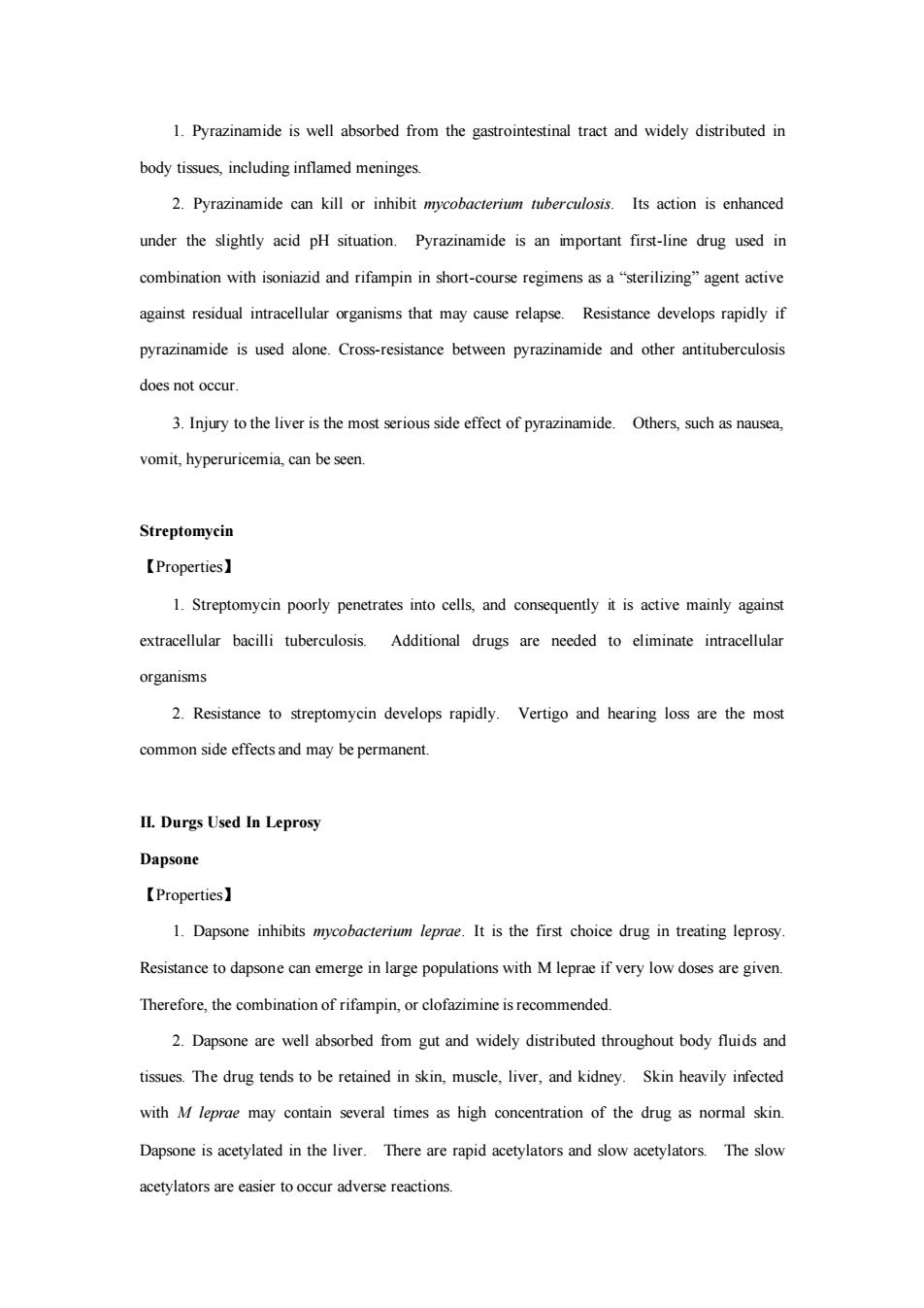
Nystatin It is too toxic for parenteral administration and is only used topically in skin and mucous membranes.Nystatin is active against most candida species and is most commonly used 【preparation and usuage】 克霉唑(clotrimazole):片剂(tablets):0.25g:0.5~1.0gbid软音剂(soft oinment): 3%,5%:膜剂(film):4mg,50mg:栓剂(suppositories):0.15g:topicaluse. 咪康唑(miconazole):胶囊剂(capsules):0.25g:0.25~0.5gbid.注射剂(injection): 0.2g/20ml 0.6~-1.8g iv gtt qd after diluted with normal saline or5%GS. (suppositories):0.Ig:topical us 酮康唑(ketoconazole):片剂(tablets):0.2g:0.2gqd.洗剂(lotio):10g:topicaluse 伊曲康唑(itraconazole):片剂(tablets):0.1g,0.2g:0.1~0.2 gpoqd.注射剂 (injection):025g/25ml:0.25giv gtt after diluted. 氟康唑(fluconazole):片剂(tablets)/胶囊剂(capsules):50mg,100mg,200mg:200- 400mg po first,then 100~200mg po qd (injection):200mg/100ml:400mg first, then20mgivgtt daferdiluted. 氟胞嘧啶(fueytosin):片剂(tablets):0.25g,0.5g:11.5 gpoqid.注射剂(injection): 2.5g/250ml:25~75mg/kg iv gtt bid after diluted. 灰黄霉素(griseofulvin):片剂(tablets):0.1g:0.2~0.3 g po bid. 两性莓素B(ernB):粉针剂(erinton):I0 m:/botle,.25 m:/bottle,. 50mg/bottle:34mg/kg iv gtt slowly after disolved and diluted with%GS:5mg first. then gradully increasing dose to51.0mg intrathecally injection after disolved. 制霉菌素(nystatin):片剂(tablets):500000IU:500000~1000000 IU po tiD or qid.软音 剂(sofointment):0000IU/g:栓剂(suppositories):10000oIU:topicalu (H Liao,Q-X Zhou)
Nystatin It is too toxic for parenteral administration and is only used topically in skin and mucous membranes. Nystatin is active against most candida species and is most commonly used for suppression of local candidal infections. 【preparation and usuage】 克霉唑(clotrimazole):片剂(tablets):0.25g;0.5~1.0g bid. 软膏剂(soft ointment): 3%,5%.;膜剂(film):4mg, 50mg;栓剂(suppositories):0.15g;topical use. 咪康唑(miconazole):胶囊剂(capsules):0.25g;0.25~0.5g bid. 注射剂(injection): 0.2g/20ml ;0.6~1.8g iv gtt qd after diluted with normal saline or 5% GS. 栓剂 (suppositories):0.1g;topical use. 酮康唑(ketoconazole):片剂(tablets):0.2g;0.2g qd. 洗剂(lotio):1.0g;topical use. 伊曲康唑(itraconazole):片剂(tablets):0.1g,0.2g;0.1~0.2g po qd. 注射剂 (injection):.025g/25ml;0.25g iv gtt after diluted. 氟康唑(fluconazole):片剂(tablets)/胶囊剂(capsules):50mg,100mg,200mg;200~ 400mg po first,then 100~200mg po qd. 注射剂(injection):200mg/100ml;400mg first, then 200mg iv gtt qd after diluted. 氟胞嘧啶(flucytosin):片剂(tablets):0.25g,0.5g;1~1.5g po qid. 注射剂(injection): 2.5g/250ml;25~75mg/kg iv gtt bid after diluted. 灰黄霉素(griseofulvin):片剂(tablets):0.1g;0.2~0.3g po bid. 两性霉素 B(amphoptericin B):粉针剂(powder injection):10mg/bottle,25mg/bottle, 50mg/bottle;3~4mg/kg iv gtt slowly after disolved and diluted with 5% GS;0.05~0.1mg first, then gradully increasing dose to 0.5~1.0mg intrathecally injection after disolved. 制霉菌素(nystatin):片剂(tablets):500000IU;500000~1000000IU po tiD or qid. 软膏 剂(soft ointment):100000IU/g;栓剂(suppositories):100000IU;topical use. (H Liao, Q-X Zhou)

Chapter 38 Antimycobacterial drugs L.Antituberculosisdrugs The first-line agents for treatment of tuberculosis have the much high efficacy with an acceptable degree of toxicity,these include isoniazid (INH),rifampin,pyrazinamide, ethambutol,and streptomyein.The second-line agents for treatment of tuberculosis include ofloxacin,ethionamide,cycloserine,aminosalicylic acid,amikacin,capreomycin, ciprofloxacin,and thioacetazone,which are used only when tuberculosis is resistant to the first-line agents Isoniazid Isoniazid,introduced in the most active drug in treatment of tuberculosis caused by susceptible strains. 【Properties of antituberculosis】 1.Isoniazid is able to penetrate into phagocytic cells and thus is active against both extracellular and intracellular organisms Isoniazid inhibits synthesis of mycolic acids which are essential components of mycobacterial cell walls. 2.Isoniazid is remarkably selective for mycobacteria.The drug is bacteriostatic for esting"bacilli but is bactericidal for rapidly dividing microorganisms
Chapter 38 Antimycobacterial drugs I. Antituberculosis drugs The first-line agents for treatment of tuberculosis have the much high efficacy with an acceptable degree of toxicity; these include isoniazid (INH), rifampin, pyrazinamide, ethambutol, and streptomycin. The second-line agents for treatment of tuberculosis include ofloxacin, ethionamide, cycloserine, aminosalicylic acid, amikacin, capreomycin, ciprofloxacin, and thioacetazone, which are used only when tuberculosis is resistant to the first-line agents. Isoniazid Isoniazid, introduced in 1952, is the most active drug in treatment of tuberculosis caused by susceptible strains. 【Properties of antituberculosis】 1. Isoniazid is able to penetrate into phagocytic cells and thus is active against both extracellular and intracellular organisms. Isoniazid inhibits synthesis of mycolic acids, which are essential components of mycobacterial cell walls. 2. Isoniazid is remarkably selective for mycobacteria. The drug is bacteriostatic for “resting” bacilli but is bactericidal for rapidly dividing microorganisms

3.Isoniazid is readily absorbed from the gastrointestinal tract.It diffuses readily into all body fluids and cells.Human populations show genetic heterogeneity with regard to the rate of acetylation of isoniazid.Isoniazid inhibits microsomal enzymes(egeytochrome P450)which reduces the elimination of numerous other drugs. 4.Resistant mutants are readily selected out if isoniazid is given alone.Therefore,it is often used in combination with other antituberculosis drugs. 【Clinical Uses】 Isoniazid is stil the most important drug of all types of tuberculosis The drug must be used concurrently with another agent for treatment of tuberculisis,although it could be used alone for prophylaxis. 【Adverse Reactions】 The incidence and severity of untoward reactions to isoniazid are related to dosage and duration of administration. 1.Allergic reactions Fever and skin rashes are occasionally seen 2.Direct toxicity Isoniazid-induced hepatitis is the most frequent major toxic effect Clinical hepatitis with loss of appetite,nausea,vomit,jaundice,and right upper quadrant pain occurs in%of isoniazid recipients and can be fatal,particularly if the drug is not discontinued promptly.The risk of hepatitis depends on age.People who are above 50or quick acetylator are easy to be caused hepatitis. 3.Peripheral neuritis Neuropathy is more frequent in slow acetylators and in individuals may prevent the development not ony of peripheral neuritis but as of most other nervous system disorders. Rifampin 【Propertiesof antituberculosis】 1.Rifampin is semisynthetic antibiotic drug with a broad spectrum activity against bacteria It binds strongly to the B subunit of bacterial DNA-dependent RNA polymerase and thereby inhibits RNA synthesis. Human RNA polymerase does not bind rifampin and is not inhibited by
3. Isoniazid is readily absorbed from the gastrointestinal tract. It diffuses readily into all body fluids and cells. Human populations show genetic heterogeneity with regard to the rate of acetylation of isoniazid. Isoniazid inhibits microsomal enzymes (eg, cytochrome P450 ), which reduces the elimination of numerous other drugs. 4. Resistant mutants are readily selected out if isoniazid is given alone. Therefore, it is often used in combination with other antituberculosis drugs. 【Clinical Uses】 Isoniazid is still the most important drug for treatment of all types of tuberculosis. The drug must be used concurrently with another agent for treatment of tuberculisis, although it could be used alone for prophylaxis. 【Adverse Reactions】 The incidence and severity of untoward reactions to isoniazid are related to dosage and duration of administration. 1. Allergic reactions Fever and skin rashes are occasionally seen. 2. Direct toxicity Isoniazid-induced hepatitis is the most frequent major toxic effect. Clinical hepatitis with loss of appetite, nausea, vomit, jaundice, and right upper quadrant pain occurs in 1% of isoniazid recipients and can be fatal, particularly if the drug is not discontinued promptly. The risk of hepatitis depends on age. People who are above 50 or quick acetylators are easy to be caused hepatitis. 3. Peripheral neuritis Neuropathy is more frequent in slow acetylators and in individuals with diabetes mellitus, poor nutrition, or anemia. The prophylactic administration of pyridoxine may prevent the development not only of peripheral neuritis but also of most other nervous system disorders. Rifampin 【Properties of antituberculosis】 1. Rifampin is semisynthetic antibiotic drug with a broad spectrum activity against bacteria. It binds strongly to the β subunit of bacterial DNA-dependent RNA polymerase and thereby inhibits RNA synthesis. Human RNA polymerase does not bind rifampin and is not inhibited by

it.Rifampin is bactericidal for mycobacteria.It readily penetrates most tissues and into phagocytic cells and kill organisms. 2.Resistant mutants are readiliy selected out if rifampin is given alone.Therefore,it is necessary for rifampin to be used in combination witn other drugs in treatment of tuberculosis. 3.Rifampin is well absorbed after oral administration and excreted mainly through the liver into bile.It then undergoes enterohepatic circulation,with the bulk excreted as a deacylated metabolite in feces and a small amount in the urine.This metabolite retains essentially full antibacterial activity.The drug may show an orange-red color to the urine,feces,saliva,sputum, tears,and sweat.Sopatients should be warned. 4.Occasional adverse effects of rifampin include rashes,thrombocytopenia,and nephritis. It may cause cholestatic jaundice,and occasionally,hepatitis and light proteinuria If administered less than twice weekly,rifampin may cause a flu-like syndrome characterized by fever,chills myalgias,and anemia Rifampin induces microsomal enzymes (eg.cytochrome P450)which increases of numerous other drugs Ethambutol 【Properties】 1.Ethambutol inhibits susceptible strains of other mycobacteria.As all antituberculous drugs,the resistance to ethambutol develops rapidly when the drug is used alone. Therefore,ethambutol is always given in combination with other antituberculous drugs Cros-resistance between ethambutol and other antituberculosis does notocu 2.Ethambutol has been used with notable success in the therapy of tuberculosis of various forms when given concurrently with isoniazid rifampin.Because of a lower incidence of toxic effects and better acceptance by patients,ethambutol has essentially replaced aminosalicylic acid. 3.The most important side effect is in decrease of visual acuity and loss of ability todifferentiate red from green.The incidence of this reaction is proportional to the dose of ethambutol. Pyrazinamide 【Properties】
it. Rifampin is bactericidal for mycobacteria. It readily penetrates most tissues and into phagocytic cells and kill organisms. 2. Resistant mutants are readiliy selected out if rifampin is given alone. Therefore, it is necessary for rifampin to be used in combination witn other drugs in treatment of tuberculosis. 3. Rifampin is well absorbed after oral administration and excreted mainly through the liver into bile. It then undergoes enterohepatic circulation, with the bulk excreted as a deacylated metabolite in feces and a small amount in the urine. This metabolite retains essentially full antibacterial activity. The drug may show an orange-red color to the urine, feces, saliva, sputum, tears, and sweat. So patients should be warned. 4. Occasional adverse effects of rifampin include rashes, thrombocytopenia, and nephritis. It may cause cholestatic jaundice, and occasionally, hepatitis and light proteinuria. If administered less than twice weekly, rifampin may cause a flu-like syndrome characterized by fever, chills, myalgias, and anemia. Rifampin induces microsomal enzymes (eg, cytochrome P450), which increases the elimination of numerous other drugs. Ethambutol 【Properties】 1. Ethambutol inhibits susceptible strains of M tuberculosis and other mycobacteria. As all antituberculous drugs, the resistance to ethambutol develops rapidly when the drug is used alone. Therefore, ethambutol is always given in combination with other antituberculous drugs. Cross-resistance between ethambutol and other antituberculosis does not occur. 2. Ethambutol has been used with notable success in the therapy of tuberculosis of various forms when given concurrently with isoniazid or rifampin. Because of a lower incidence of toxic effects and better acceptance by patients, ethambutol has essentially replaced aminosalicylic acid. 3. The most important side effect is optic neuritis, resulting in decrease of visual acuity and loss of ability to differentiate red from green. The incidence of this reaction is proportional to the dose of ethambutol. Pyrazinamide 【Properties】

1.Pyrazinamide is well absorbed from the gastrointestinal tract and widely distributed in body tissues,including inflamed meninges. 2.Pyrazinamide can kill or inhibit mycobacterium tuberculosis.Its action is enhanced under the slightly acid pH situation.Pyrazinamide is an important first-line drug used in combination with isoniazid and rifampin in short-course regimens as a"sterilizing"agent active against residual intracellular organisms that may cause relapse.Resistance develops rapidly if pyrazinamide is used alone.Cros-resistance between pyrazinamide and other antituberculosi does not occur. 3.Injury to the liver is the most serious side effect of pyrazinamide.Others,such as nausea, vomit,hyperuricemiacan be seen. Streptomycin 【Properties】 1.Streptomycin poorly penetrates into ell,and it is active mainly agains extracellular bacilli tuberculosis. Additional drugs are needed to eliminate intracellular organisms 2.Resistance to streptomycin develops rapidly.Vertigo and hearing loss are the most common side effects and may be permanent II.Durgs Used In Leprosy Dapsone 【Properties】 1.Dapsone inhibits mycobacterium leprae.It is the first choice drug in treating leprosy. Resistance todapsonecnemerge in large populations with Mleprae if very low doses are given. Therefore of 2.Dapsone are well absorbed from gut and widely distributed throughout body fluids and tissues.The drug tends to be retained in skin,muscle,liver,and kidney.Skin heavily infected with M leprae may contain several times as high concentration of the drug as normal skin. Dapsone is acetylated in the liver.There are rapid acetylators and slow acetylators.The slow acetylators are easier to occur adverse reactions
1. Pyrazinamide is well absorbed from the gastrointestinal tract and widely distributed in body tissues, including inflamed meninges. 2. Pyrazinamide can kill or inhibit mycobacterium tuberculosis. Its action is enhanced under the slightly acid pH situation. Pyrazinamide is an important first-line drug used in combination with isoniazid and rifampin in short-course regimens as a “sterilizing” agent active against residual intracellular organisms that may cause relapse. Resistance develops rapidly if pyrazinamide is used alone. Cross-resistance between pyrazinamide and other antituberculosis does not occur. 3. Injury to the liver is the most serious side effect of pyrazinamide. Others, such as nausea, vomit, hyperuricemia, can be seen. Streptomycin 【Properties】 1. Streptomycin poorly penetrates into cells, and consequently it is active mainly against extracellular bacilli tuberculosis. Additional drugs are needed to eliminate intracellular organisms 2. Resistance to streptomycin develops rapidly. Vertigo and hearing loss are the most common side effects and may be permanent. II. Durgs Used In Leprosy Dapsone 【Properties】 1. Dapsone inhibits mycobacterium leprae. It is the first choice drug in treating leprosy. Resistance to dapsone can emerge in large populations with M leprae if very low doses are given. Therefore, the combination of rifampin, or clofazimine is recommended. 2. Dapsone are well absorbed from gut and widely distributed throughout body fluids and tissues. The drug tends to be retained in skin, muscle, liver, and kidney. Skin heavily infected with M leprae may contain several times as high concentration of the drug as normal skin. Dapsone is acetylated in the liver. There are rapid acetylators and slow acetylators. The slow acetylators are easier to occur adverse reactions